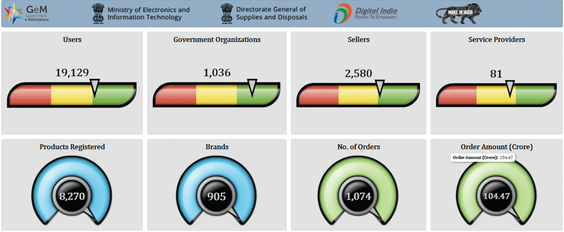Feature Stories
- How Bangladesh bridged the gap between amateur and professional in government procurement
- Rated Criteria: Promoting Value in World Bank Procurement
- Public Procurement Transformation in Bangladesh
- Achievement of Value for Money and Enhancement of Efficiency, Economy and Transparency in Procurement - Document Archive System
Archives
- End-to-End Procurement Planning and Maintenance System Integrated with Project MIS
- Application of Construction Milestones in Rural Road Contracts of Nepal
- Gross National Happiness Model for Pursuing Sustainable Public Procurement
- Government procurement is the basis of wide opportunities for enterprise development
- The Challenges of Procurement Training in a Fragile Country: the Afghanistan Experience
- When and How to Open Contracts: Transparency and Engagement through World Bank Projects
- Innovations and Best Practices in Procurement Processes of Disaster Recovery Projects
- World Bank Experts Discuss Global Procurement Trends and Armenia's e-GP system with the National Assembly
- Technology driving transparent and accountable public procurement reform in Bangladesh
- Prototype for Implementation of Framework Agreement via Blockchain
- Construction Project Planning and Management Capacity Building in India: A Wholistic Approach to Boost Infrastructure Development
- Zimbabwe: Public Procurement reform to catalyze greater transparency and development
- 15th Procurement, Integrity, Management and Openness (PRIMO) Forum
- e-Procurement World Map
- Preventing and controlling corruption: A modern approach to Procurement
- 6th South Asia Public Procurement Conference held in Thimphu, Bhutan
- South Asia Procurement Innovation Awards 2018 Announced
- Procurement iNET completes 5 years and new CPPP Fastest 100% Challenge Launched
- Risky Business: Does Debarring Poor Performers Mitigate Future Performance Risk?
- Global Procurement Summit 2019, New Delhi, India
- World Bank India launches Survey for International Civil Works Contractors
- World Bank launches new Complaints Module in Systematic Tracking of Exchanges in Procurement (STEP) System
- New Open Contracting Data Standard for e-Procurement Systems Launched
- Bangladesh's success in public procurement: Sustained reform really pays off
- The five drivers for improving public sector performance: Lessons from the new World Bank Global Report
- South Asia Public Procurement Innovation Awards 2018
- Conversation with Khaled Elarbi, President, High Authority for Public Procurement (HAICOP), Tunisia on the Digitalization of Public Procurement
- Breaking the glass ceiling in Africa: Rwanda E-Government Procurement System
- How government e-marketplace is revolutionizing procurement in India
- Ensuring Value for Money in Infrastructure Projects - The Botswana way
- Blockchain Lessons for Procurement
- Botswana’s Benevolent Move to Enhance its Procurement Profession
- Achieving Better Value for Money Using e-Auction for Procurement of Goods by Public Sector - A Success Case from DPDC
- Guide to Project Management and Contract Management (GPMCM) – New Approach to Improve Efficiency and Effectiveness of Procurement Outcomes
- Regional Winners of SAPIA 2017 participate in 8th International Public Procurement Conference (IPPC 8) Arusha, Tanzania
- The Future of Public Procurement in the Era of Digitalization
- World Bank Operations Procurement Helping Turkey to Procure a US$2 Billion Gas Storage Facility
- Unlocking Energy Efficiency Market in India - Through Innovative Procurement Business Model
- Getting value for money: Creating an automated market place for farmers in Pakistan
- Towards a Single Market for Public Procurement in Caribbean Small States
- Web-Based Online Evaluation Tool (e-Tool) for Procurement of Works by Royal Government of Bhutan
- Strengthening Health Sector Procurement System Offer Hopes for Universal Health Coverage in Nepal
- Morocco makes Strides in Modernizing its Public Procurement System— Operationalization of the Procurement Regulatory Body
- Innovations in Procurement Process and Selection that Lead to Improved Outcomes – Tenderers’ Database Management System
- Looking Back and Forward: The World Bank’s Procurement Framework
- Independent Monitoring and Evaluation of Contracted Health Services Leads to Improved Outcomes in Rural Areas of Afghanistan
- Fifth South Asia Region Public Procurement Conference brings focus on Procurement in Public Service Delivery
- 12 Procurement Innovations from South Asian Countries Celebrated
- Social Media is Improving Procurement in Lao PDR
- ASEAN meeting explores ways of professionalizing public procurement to meet development challenges
- Second International Training Program on the World Bank’s New Procurement Framework
- South Asia Procurement Innovations Award 2017 launched with Bigger and Better Prizes
- How to bid, finding opportunities, what makes a successful bid
- Pushing boundaries in procurement framework implementation
- Experience of Developing PPSD for the Assam Agribusiness and Rural Transformation Project (APART), India
- An Electronic Approach: Streamlining Georgia's Procurement
- South Asia Heads of Procurement Knowledge Exchange Program to U.S. Government Procurement Systems started
- 13th Procurement, Integrity, Management and Openness (PRIMO) Forum - a Documentary
- Bangladesh to strengthen public procurement with World Bank supported Project
- Establishment of Technology-Based Health Procurement and Supply Chain Management System, and Capacity Development in Tamil Nadu Medical Services Corporation
- Towards a Single Market for Public Procurement in Caribbean Small States
- Redefining Procurement as an Innovative and Collaborative Centre of Excellence for Best-in-Class Sourcing Solution
- India’s PowerGrid Endorsed for Alternative Procurement Arrangements by the World Bank
- Achieving Value for Money in Indonesia’s Geothermal Project
- Citizen Monitoring of Rural Roads Under Pradhan Mantri Gram Sadak Yojana (PMGSY), India
- Establishment of Grant and Service Contract Management Unit (GCMU) to Manage Contracting Out of Health Services in Afghanistan
- Procurement for Regional Development–Public Policy Initiative in Sri Lanka
- PPAF Community-Driven Development (CDD) Procurement Model, Pakistan
- Making Successful Procurement of IT Systems - An Experience from Vietnam
- Procurement Observatories continue to deliver in India
- Implementation of National e-GP System in Nepal
- Government e-Marketplace (GeM), India
- Africa High Level Public Procurement and Electronic Government Procurement Forums
- Development of Procurement Cadre as Part of Holistic Procurement Reforms in Bhutan
- Modernizing Public Procurement in Zimbabwe, one Step at a Time
- Citizen Engagement During Public Procurement Implementation in Bangladesh
- Winter 2017 Virtual Procurement, Integrity, Management, and Openness (PRIMO) Forum on Sanctions and Debarment Systems
- Close and Personalized Procurement Monitoring, Leading to Procurement Efficiency in Irrigation Sector in Fragile and Challenging Environments of Afghanistan
- Procurement Framework 2016 offers wider choices to ‘Go to Market’ based on PPSD
- Procurement Framework 2016 - Benefits, Status of Roll-out and M&E Arrangements
- PPSD offers Fit for Purpose Procurement Solutions
- Global Procurement Summit
- Fourth South Asia Region Public Procurement Conference
- The World Bank e-Procurement Tools
- South Asia Procurement Innovations Awards, 2016
- Learning Videos launched on STEP, online tracking tool on procurement for World Bank Projects
- Open e-Learning is Building a Cadre of Procurement Experts
- South Asia Region Public Procurement Conference, 2017
- Online Certificate Program in Public Procurement in Arabic Launched in Egypt
- First Procurement Knowledge Exchange Forum among ASEAN Countries
- Nobel Prize in Economics for contribution to Theory of Contract
- The Africa Region Harnesses Integrated e-Government Procurement (e-GP) Systems in Pursuit of Transparency and Integrity
- Procurement Reform for Humanitarian and Development Challenges in Kurdistan Region of Iraq (KRI)
- Successful Procurement is not just a set of Activities, it is a Strategy
- Afghanistan - Trends and Recent Developments in Governance
- PPSD is an Opportunity for clients and staff for Improved Procurement Management
- Procurement Reform Advances in the MENA Region
- Data Analysis and Collaborative Work in Action for Expedited Disbursements in Africa
- Ensuring Good Governance in Procurement in Sri Lanka
- New Procurement System to Improve Development Impact and Transparency in South Asia
- World Bank, USTDA Formalize Procurement Partnership
- How the New Procurement Framework Will Benefit 45.6 Million People in India
- Procuring the Future
- Reasons to Bid, Finding Business Opportunities
- New World Bank Procurement Framework Promotes Strengthened National Procurement Systems
- The readiness for Procurement Framework 2016
- 6 Things to know about New Procurement Framework
Government e-Marketplace (GeM), India


{This article is an abridged version of the submission on “Government e-Marketplace (GeM)” made by Mr. Binoy Kumar, Director General, Supplies and Disposal, Government of India, for the South Asia Procurement Innovation Awards.}
Summary
Government e-Marketplace (GeM) is an end-to-end online procurement system for commonly used items of the Directorate General of Supplies and Disposal, (DGS & D), Government of India. Developed using private e-marketplace design and processes, GeM offers buyers a huge list of products for individual categories of Goods/Services to shop for. Search, Compare, Select and Buy facility, a continuous Vendor-Rating system, and an easy Return policy makes GeM a convenient platform for buyers.
GeM is revolutionizing Indian public procurement scenario by making it paperless, cashless, and faceless. It is helping in cutting down administrative and transaction costs significantly for buyers and bidders. The innovation, built on modern e-commerce technologies, coupled with verifiable means of authenticity of suppliers and purchasers, allows a fully reliable procurement transaction to be done completely online. Within a few months of launch, GeM has become popular with over 19,000 users registering on the platform. It has integrated 1,036 Government department-buyers, 2,580 sellers, 81 service providers, 8,270 products / services, and delivered 1,074 orders worth USD 16 million as of January 2017.
Background
The Good Governance initiative of the Government had a stated objective of Minimum Government and Maximum Governance. As part of this, two Groups of Secretaries to the Government of India recommended that the current Government procurement system be reviewed and redesigned. They went on to state their preference for a market-based, open, and transparent framework in line with the Digital India Vision — Paperless, Cashless, and Faceless.
Procurement operations in India are typically delegated to procurement entities on a deconcentrated model based on the financial delegation levels permitted. These are covered by the regulatory framework of General Financial Rules (GFR). Directorate General of Supplies and Disposal, established for procurement for the Union Government, has a facilitating role in establishing rate contracts (similar to framework agreements). Over the last 65 years, DGS & D has set up over 3,000 rate contracts covering over 20,000 products. In an economy with a $2.3 trillion GDP and an estimated 15% of that being public procurement, around 700,000 tenders are issued every year by Government procuring entities. The aspiration was to leverage the technologies that were available and transform the way Government procured its daily use goods and services, leading to higher efficiency in cost, time, and efforts.
GeM (https://gem.gov.in/) was developed under the guidance of Directorate of Supplies and Disposal, Department of Commerce, Government of India, with technical collaboration of National e-Governance Division, Ministry of Electronics and Information Technology, Government of India.

The key challenges that are addressed by GeM include:
- Crafting a solution that cut down significantly on administrative and transaction costs on commonly and repeatedly procured items for both Government buyers as well as suppliers, for example transportation (or taxi) services.
- Eliminating multiple levels of manual, sequential verification and decision-making to bring down lead-time in procurement.
- Instilling confidence amongst all stakeholders, including vendors, of an open, inclusive, and competitive process.
- Reducing the physical means of financial transactions of various types of payments.

The idea of a Government procurement marketplace was an out-of-the-box approach to the challenges faced and has many elements of innovation.
- The ability of Government-buyers to interface and transact directly with potential suppliers in a manner that was faceless, paperless, and cashless conformed completely to the Digital India vision of governance.
- The end-to-end platform was able to get a strong buy in from multiple stakeholders with varied objectives on the aspect of procurement. They ranged from Finance, Audit, Accounts, and Vigilance functions within the Government to market providers that included Industry, OEMs, Retailers, and Banks, among others.
- GeM introduced many new ways of efficient procurement, particularly for services, which the Government had not done ever before e.g. the provisioning of transportation (taxi) services with spot-hiring, leasing, renting, among other options, in collaboration with global leaders Uber and Ola.
- GeM successfully addressed various entry barriers for vendors by simplifying the onboarding process and reduced the time frame dramatically. The traditional vendor rate contract cycle that lasted for 6 to 8 months was transformed to an online vendor registration that just took 20 minutes! This was achieved by securing offers through eSign that established an audit trail.
- GeM leverages cross-platform authentication of seller credentials, with individual identities verified through Aadhaar (the Unique Identification program of the Government of India) and the financial standings of individuals and supplier organizations through their Permanent Account Number (PAN) issued by the Income Tax Department.
- The platform features include best-of-breed e-commerce functionalities, such as Easy search, Price comparisons, Selection, Order placement, e-Bidding, Reverse auction, Demand-aggregation, Dynamic pricing by sellers/service providers amongst many more.

Impact Generated
GeM has rationalized the procurement processes, brought in complete transparency and traceability, reduced lead-time, enabled parallel auditing, and increased the overall effectiveness of procedures.
Successful roll out of GeM has impacted many facets of procurement policy and management, and demonstrated high value. At a policy level, a new service level of “Payment within 10 days of delivery and its acceptance” was introduced as a new Rule in the GFR to enable procurement through GeM. In a very short time, GeM has gained the confidence of multiple stakeholders, as seen from the high number of vendor and product registrations.
Within 120 days of launch, GeM has integrated 1,036 Government department-buyers, 2,580 sellers, 81 service providers, 8,270 products / services, and delivered 1,074 orders worth USD 16 million as of January 2017. GeM’s acceptance by various Government departmental buyers is a testimony of its success. Trends indicate that there will be bigger growth in procurement transactions with more Government-buyers, national and state, queuing up to be onboarded on GeM. The World Bank has permitted purchasing of up to USD 30,000 on GeM portal for bank-funded projects.

Above all, GeM is setting the benchmark for Government agencies to adopt usage of newer and faster technologies, even if it means borrowing from the private sector. It is a proud addition to the national repository of effective, transparent, user-friendly IT-based platforms that take the Digital India agenda forward to a digitally-empowered society and nation.

Scalability and Sustainability
GeM is conceptualized around generally acceptable / prudent financial rules in Government departments, making it easy to replicate, adopt, or adapt the solutions by any Government entity, be they from the central or state governments, PSUs, or autonomous-bodies. GeM’s architecture has been designed to make it easy to scale-up and up-scope, as it is modular. Functionalities of the portal have been so formatted to allow modification for use by other institutions or national states with minimal efforts, thereby reducing wastage. By doing this, GeM curbs the need for Government buyers starting individual e-solutions and seeks to bring them all under one roof of a universal procurement solution. GeM is developed as a full stack Open Source application platform and deploys effective load balancing and caching to make it a high-availability solution even during peak loads.

While a number of lessons came up during the design, development and deployment of GeM, the key lessons include:
- The architecture and technology stack for a solution like GeM needs to be agile to dynamically keep up with demands of both vendors and buyers. On an average, the team addresses about 250 queries per week.
- To build confidence in a buyer, concurrent oversight and auditing by competent agencies need to be enabled.
- To keep up with the pace of such e-solutions, there needs to be constant feedback and repetitive training sessions of levels that operate the system to ensure no inadvertent errors or erroneous decisions are taken. Buyers, vendors, and providers need training and continuous handholding on registering and on-boarding products.
- Any process-oriented application that generates documents needs to have a foolproof audit trail with an efficient document management system.
